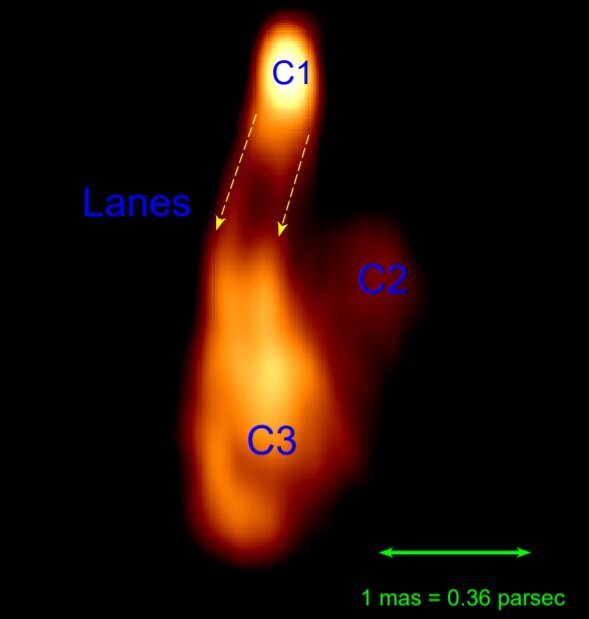
An international team of astronomers has conducted a detailed kinematic study of a radio galaxy known as 3C 84. The research sheds more light on the properties of this source and its connection to gamma-ray emission. The study was detailed in a paper published April 7 on the arXiv pre-print repository.
Radio galaxies emit huge amounts of radio waves from their central cores. Black holes at the centers of these galaxies accrete gas and dust, generating high-energy jets visible in radio wavelengths, which accelerate electrically charged particles to high velocities.
Astronomers are especially interested in studying gamma-ray bright misaligned radio galaxies as they can provide a unique opportunity to probe the high-energy emitting sites and particle acceleration processes. These sources are observed off-axis, which allows researchers to transversely resolve the fine scale structure of the jet and to investigate its connection
with gamma-ray emission.
Located in the Perseus Cluster at a redshift of 0.018, 3C 84 is the radio counterpart of the Seyfert Type 1.5 galaxy NGC 1275 (other designation Perseus A). Given that 3C 84 is one of the brightest radio galaxies, its jet morphology has been extensively studied in the past. The observations show that the most recent jet activity of this radio galaxy most likely began in 2005, with a general increase in flux density in the source and the creation of a region known as C3, which was ejected from the presumed jet launching region C1. Moreover, the source also has a large, faint area of quasi-stationary emission, dubbed C2, about 40 degrees offset from the current jet emission.
However, although many studies of 3C 84 have been conducted and that it was detected at gamma-rays up to TeV energies, the physical processes responsible for the high-energy emission from this source remain poorly understood. So a group of astronomers led by Jeffrey A. Hodgson of Sejong University in Seoul, South Korea, performed a thorough analysis of the jet kinematics in 3C 84 between 2010 and 2017.
“In this paper, we present the results of the wavelet-based image segmentation and evaluation (WISE) analysis method for the jet kinematic analysis of 3C 84 using 7 mm VLBA [Very Long Baseline Array] data from 2010 until 2017, and have compared it against CLEAN maps,” the researchers explained.
The study shows that the radio structure of 3C 84 is dominated by slow moving features in both eastern and western lanes of the jet. The jet itself appears to have accelerated to its maximum mildly relativistic speeds within the radius that equals 125,000 times the gravitational radii of the jet launching point, and stays at a roughly constant velocity for many further.
The research found a maximum speed in the jet of about 90% of the speed of light, leading to a minimum Lorentz factor of approximately 1.35. The data indicate that gamma-ray flares are observed when faster moving regions interact with slower moving regions of 3C 84.
Furthermore, the observations detected two hotspots in C3 that become bright and then dissipate to the west. The second hotspot began to brighten in late 2015, and seems to be associated with a particularly large gamma-ray flare.
All in all, the results allowed the astronomers to draw some conclusions regarding the gamma-ray emission from the studied source.
“Our study indicates that gamma-rays are produced in both eastern and western lanes in the jet. We discussed the possibility of gamma-ray flares being produced via magnetic reconnection induced mini-jets and turbulence. Moreover, we find the evidence that there could be an excess of magnetic energy or gradients in pressure and the ambient medium,” the authors of the paper wrote. https://phys.org/news/2021-04-radio-galaxy-3c.html







Recent Comments